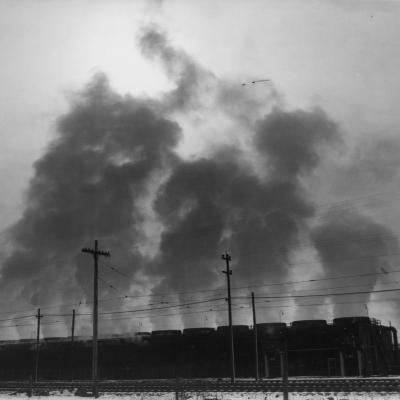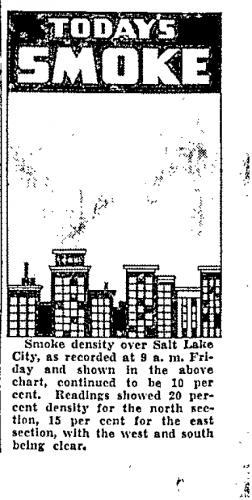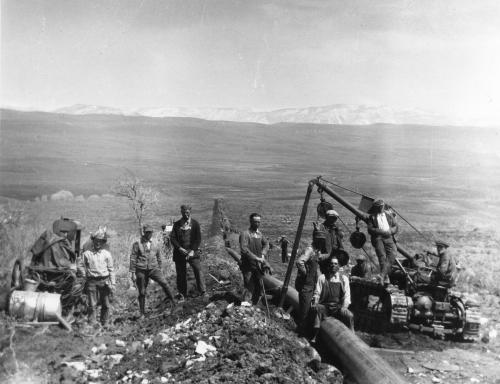Utah Air Quality History, 1930s–1960s
In the early 1930s, with the onset of the Great Depression, public interest in air quality issues declined temporarily. This coincided with the introduction of natural gas into the Salt Lake area, via a newly-constructed pipeline to fields in Wyoming, offering a fuel source that did not produce the visible pollution that coal combustion did. (The Works Progress Administration, a New Deal public works agency, also created jobs monitoring air quality in Salt Lake.) Residents were slow to make the switch to natural gas, however, and stubbornly poor air quality led to renewed political activism focused on reducing air pollution by the mid-1930s, this time dominated by the city’s leading women. The Salt Lake Women’s Chamber of Commerce (with no official affiliation to the Salt Lake Chamber of Commerce) was created in 1936 for the express purpose of persuading city leaders to adopt policies that would lead to improved air quality. The Women’s Chamber published educational pamphlets, held regular radio broadcasts, and petitioned the city government to do more for air quality. In collaboration with scientists at the University of Utah, they developed a detailed proposal for the construction of a coal processing plant in Salt Lake that would extract oil and gas from Utah coal and produce “smokeless” anthracite coal; they even shipped a sample of Utah coal to a processing plant in Germany for experimentation. Though their proposals were never fully adopted, the Women’s Chamber was an important force in city politics until the United States’ entry into World War II in December 1941. In fact, it was the women's pressure on the smoke nuisance problem that prompted the 1941 visit of St. Louis by the Chamber of Commerce representative Gus Backman and Smoke Inspection Engineer, William L. Butler to investigate their smoke abatement program. It was from this trip that Salt Lake City modeled their plan of a gradual reduction in emissions, rather than complete elimination, which was met with protests from the Women's Chamber.
During the war years public attention to air quality decreased significantly, as defense production became the top priority. Because of the dramatic increase in industrial production, air quality in Salt Lake became much worse. After the war ended in 1945, however, the smoke issue regained public attention and air quality in Salt Lake began to improve drastically. In 1946, the Salt Lake Telegram ran a four-part series on the history of the smoke problem: how it was a result of the city's rapid economic development, how anti-pollution efforts had been intermittent, how the government's many initiatives had failed to solve the problem, and how after 1936 women assumed a central role in the public debate concerning air quality. Also in 1946, the Telegram ran article which demonstrates a developing knowledge of the temperature dynamics that trap pollutants in the valley during periods of cold whether and would, after the 1950s, be called "inversions."
In the late 1940s, the state—not the city—finally built the kind of coal processing plant for which the Women’s Chamber had so long argued, but it was only in operation for a couple of years. By then the conversion to natural gas was in full swing, and coal consumption continued to decline through the end of the 1950s as both homes and industries converted to natural gas. Despite the resulting improvements in air quality, however, a new problem was beginning to emerge: unregulated automobile emissions. In the early 1960s the Utah legislature accepted a study that chronicled the history of air quality in the state and summarized the current scientific understanding of air pollution—what factors contributed to it, what the pollutants were, and what was being done about it. After the report, the legislature for the first time defined air pollution legally as a public nuisance, criminalizing the creation of pollution that harmed people, animals, plants, or property. Another law followed in 1967 that created the Air Conservation Committee, within the state Department of Health, to combat air pollution. Through the late 1960s the scientific study of air quality continued to advance, and a large air quality conference was held at the University of Utah in 1969, but pollution remained a major issue.
In the late 1960s the state legislature passed Utah's Air Conservation Act (1967), creating the Utah Division of Environmental Quality (DEQ) and Air Quality board. The federal Environmental Protection Agency (EPA) was created in late 1970.






